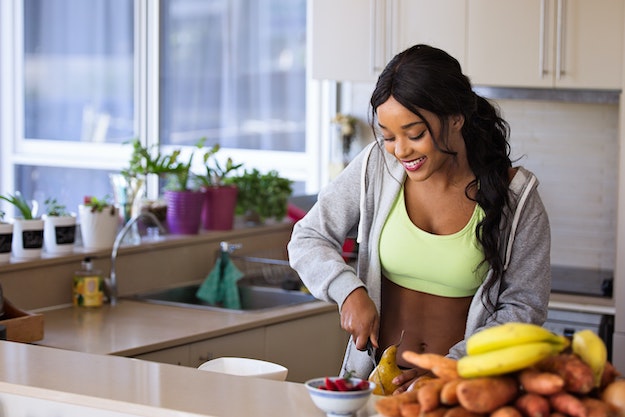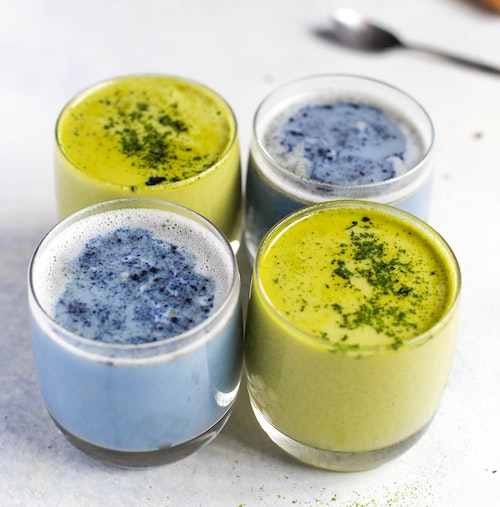I firmly believe that leading a healthy lifestyle doesn’t have to be as hard or as daunting as most people make it out to be.
With the help of the internet — which contains a plethora of priceless information, advice, and research on how to overcome most problems people face — as well as a bit of creative thinking and habit formation, I truly believe we can always come up with clever, easy, and simple solutions to the problems we face, especially when it comes to leading a healthier lifestyle.
I’ve definitely struggled with healthy eating and committing to a regular exercise routine myself, but over the years, I’ve significantly improved in these ways, using a few simple and creative tips and tricks, which I share below:
For Healthier Eating:
- Eat healthy foods first. This might seem like an obvious suggestion, but it’s surprising how few people actually do this when it would really help them.
Often times, no matter how pure our intentions to consume some healthy foods are, when we allow ourselves to give into temptation right away, the healthier foods we initially planned on having will seem dull and boring in comparison. As a result, we’ll not want to eat any of the healthy foods anymore. Or, we’ll unintentionally have more than one serving of the unhealthy foods, especially if we’re hungry, until we no longer have any room left for the healthier foods and then decide not to have them.
We may even tell ourselves that we’ll do this “just this once,” when it ends up being the way we handle our cravings the majority of the time. So, by following the above suggestion, you can avoid experiencing this altogether. Also, by delaying instant gratification in healthy and realistic ways, you will likely be more committed to doing this long-term and will develop more discipline. As a result, practising moderation will get easier over time. - Place the amount of junk food or dip that you intend to eat on a separate plate or dish (and save the rest for another time), rather than eating it directly from its packaging.
Before you start eating anything, put the rest away so that it isn’t as convenient to grab more, which will reduce the chance that you will grab more. But even if you do grab more, remember that it is okay (we all do this sometimes, we’re human), and just do the same thing all over again—place the amount you want on a separate dish, and then put the rest away, out of sight, before you start eating it.
This strategy works great because it allows you to not just rely solely on will power to signal when to stop eating something unhealthy. While it is important to learn how to listen to inner bodily cues and develop strong will-power, relying on these strategies alone to stop you from eating too much junk food all the time aren’t the best methods to depend on long-term, as people tend to be unrealistically optimistic about these abilities. However, with the suggested method, you now have the added visual cue of the amount of junk food remaining on your plate to signal how much of it to eat. - Add a versatile kind of leafy green (e.g., spinach) underneath your food (as shown in the image below). This will increase the nutritional content of your meals. Also try adding a bunch or small handful of spinach to smoothies – you won’t taste it (unless you overdid it).

- Have a wide supply of delicious and fairly healthy seasonings, sauces, and condiments at your disposal to quickly jazz up healthy meals and snacks (especially bland vegetables!) in a pinch. It is incredibly helpful to have a wide selection of this to 1) satisfy various cravings and 2) help you whip up a healthy meal or snack in little time and effort.
- Similar to my last point: sneak as many herbs and spices into your foods as possible. You would be surprised how much more antioxidants can be added to a dish with the help of a few extra spices and herbs. For example, I like to add a bit of turmeric to any savoury food I’ve added pepper to, since turmeric has a fairly mild flavour for a spice, as well as powerful nutritional benefits. As nutrition expert Jolene Hart explains in her book Eat Pretty Every Day(Amazon) on page 207:
“A few shakes of turmeric add important beauty benefits—including a reduction of inflammation and a dose of powerful antioxidants—to any meal thanks to its potent phytochemical curcumin. But if you remember to season with black pepper as well, you’ll increase the amount of curcumin available to the body by a whopping 2000 percent. Even a pinch of black pepper does the trick, to more completely nourish your beauty and your health.”
– Jolene Hart, Eat Pretty Every Day
- On a related note, read 1 page of Jolene Hart’s book Eat Pretty Every Day (from Amazon) for a paragraph of health-related inspiration each day of the year “for nourishing beauty, inside and out.” Definitely worth the purchase in my opinion.
- Keep a list of healthy snack alternatives for any kind of craving in highly visible areas, such as on your fridge, cupboards, or anywhere else where you can use a powerful reminder of what other foods you could have to satisfy cravings in healthier ways.
- Also keep a list of your favourite healthy, quick, and easy meals to make in highly visible areas (e.g., on your fridge, etc.). Doing this can reduce how often you feel compelled to eat out when you’re feeling tired and you think about how much effort goes into cooking in general, since these meals will ideally involve very little effort and time.
- Keep healthy foods highly visible and unhealthy foods out of sight. Because we have the tendency to eat what we can see, as well as what we think about (and we think about what we can see), it is ideal to regularly re-arrange foods in your fridge, cupboards, pantry, and elsewhere so that your healthier foods remain highly visible at all times. Doing this will reduce your chances of forgetting about them, especially when an unhealthy craving strikes. You’ll also want to keep unhealthier foods out of sight as much as possible so that you’re not constantly reminded of them, as that can re-ignite your cravings.
- Drink Lots of water. This is another one of those basic, but great tips we hear everywhere and agree with, but never actually put into practise, even though it could really help us! Ideally, strive to drink 1 cup of water before each meal, and another cup (or 2) after meals. I started doing this recently and it has really been a game changer for me. After doing this, my desire to eat junk food after meals is significantly reduced – I have no idea why I haven’t done this before!Also, always bring lots of water with you, wherever you go, and always keep it near you, in highly visible areas at home. You can store the water in a visually appealing bottle, pitcher, glass, or jar, to make drinking seem more compelling to you. You can even try flavouring your water with different fruits, herbs, vegetables (e.g., cucumber), edible flowers, or herbal teas to make the act of drinking water seem a bit more tastey, interesting, and easier to remember to do.

- Prep a few simple, healthy snacks in advance or keep a constant supply of ready-made ones available. For example, if you like veggies and dip, always having a healthy dip on hand, such as hummus, and a few veggies, can be extremely helpful. Make sure there is something prepared for both sweet and salty/savoury cravings. I have found that prepping snacks, such as by simply chopping vegetables beforehand, dramatically increases the chances that I will eat them.
You can even do this for foods that can be eaten as-is and hence don’t really need to be prepped (e.g., by chopping apples, slicing strawberries, etc.), if doing so will make them appear much more appetizing to you, as that will also improve your chances of eating them.
- Prep aspects of your meals in advance or purchase a few ingredients that will make cooking meals a little easier and more convenient to do (i.e., shredded cheese, cauliflower rice, minced garlic, etc.), especially if you hate cooking. While these kinds of foods tend to be more expensive, creating a meal with such ingredients yourself is still much cheaper than eating the same kind of meal at a restaurant would be, and might even still be cheaper than fast-food! I also like that cooking with these kinds of ingredients often makes the cooking process significantly less messy (and obviously quicker). Personally, I know I tend to be thankful whenever I purchase these kinds of ingredients.
But you can also try making these conveniences yourself, in advance of the cooking process (i.e., by shredding a big batch of cheese, creating zoodles, peeling vegetables, etc.), to save money as well as time in the future to actually make the meal. I don’t like to cook entire meals in advance because I highly value the freshness of recently-made meals, so I prefer to leave the actual cooking process to the end, and will instead just prep the vegetables and any sauces in advance (if I know they’ll last well in the fridge for a few days). - Similarly, wash produce as soon as you return home from grocery shopping, so they’re ready-to-go as soon as you want to eat them.
Even though washing produce is such a quick and easy thing to do, if you are tired enough, you won’t do it when you want to eat your produce. You may even opt for junk food instead simply because it’s more convenient to eat, but if we can simplify all the steps involved in preparing produce and healthy snacks/meals in general as much as possible, then we are much more likely to maintain healthy eating habits over the long haul, despite how we might feel in a given moment.
It is so important to never assume that you will always have abundant energy, time, and motivation to do these seemingly simple steps, so if we fail to plan for the worst, then we plan to fail, since we can’t always guarantee that we will have optimal external and internal (e.g., mental, emotional) conditions 100% of the time. - Avoid multi-tasking while eating, if possible. Multi-tasking can cause you to enjoy the process of eating your food less, since we’re not really paying much attention to it, which can actually cause you to eat more in an effort to try to satisfy yourself.
Similarly, we tend to overeat while watching T.V. and other forms of entertainment to try to make the experience of entertaining ourselves as enjoyable as possible. However, the issue with doing this is that entertaining ourselves often takes up more time than eating does, so if we like to eat the entire time we watch a show, for example, then we will eat as much extra food as we need to until we’re done watching it.
Doing this can definitely lead to regular over-indulgence and should ideally be kept to a minimum. Strive to eat mindfully instead by focusing your attention on the tastes, smells, and textures of your food as much as you can.

- Regularly find new, inspiring recipes each week that you’re excited to try out. Try to find at least 1 new recipe to try out each week, and do not gather more recipes than you can make for the week, as you ideally want all the recipes to feel relatively “new” each week, otherwise your inspiration and excitement for them might fade over time, and you may feel less inclined to make or eat them.
Also strive to obtain at least 1 recipe that is quick and easy to make, since you can’t always guarantee that you will have as much time and energy as you may think you do to devote to cooking throughout the week—it is always ideal to be realistic with yourself to ensure that you will be able to sustain a habit long-term. - Become aware of the mistaken, detrimental beliefs you have deep down that prevent you from making healthier decisions, and reframe your thoughts about them. You can enhance your awareness of them and the inherent biases that they are based on by reading my post about them here.
For Adding More Physical Activity into Your Life:

- Do a few reps of at least 1 kind of exercise every day (squats, lunges, sit-ups, etc.), ideally in the morning. This will ensure you won’t forget to do it throughout the day. For example, every morning I do 60 bicycle reps, since I really enjoy this kind of exercise and my stomach is my “problem spot,” but feel free to choose a different kind of exercise each day for more balanced muscle development. Doing something, however little it may be, is certainly better than doing nothing.
- Get in the habit of moving during breaks in-between your work sessions. This can be as simple as doing some light stretches, and there are many that can be done while sitting (e.g., if you’re in an office setting).
The goal here is to learn to do this spontaneously during any short gaps of time (e.g., while cooking, being on hold during a phone call, etc.), without needing to constantly remind yourself to do this. Doing this can potentially provide you with so much more energy and physical activity throughout the day, WITHOUT trying too hard. You can try setting alarms or reminders on your phone to remind you to keep doing this at first, until it becomes an automatic habit that is seamlessly interwoven into your everyday life. - Take the stairs, and walk or bike wherever possible, of course.
- Use either a full-sized exercise bike or a mini exercise bike (i.e., for underneath a desk). Mini exercise bikes (Amazon) are great if you love to multi-task and maximize your productivity, as long as you have a tall table or desk to put it under, since most desks and tables would be too low to use these without hitting your knees on them.
However, if you intend to use it while listing to audiobooks or watching T.V., then this is not a problem at all, especially in tighter spaces, or if you just want to keep it conveniently stored under a desk. But if space is not an issue for you, then it might be better to use a real indoor bike (Amazon), as they often have a greater range of motion and more resistance levels to work with which will offer you a better, more challenging workout. You might even be able to find some bikes that come with mini desks attached to them, which combines the benefit of being able to do work while getting a better workout (compared to mini bike).
Indoor bikes—both mini and large ones—are great for improving mobility, if that is an issue you struggle with. Compared with treadmills, bikes are often much more affordable, while also being significantly more gentle on the joints, which is why I actually prefer them myself. - Only challenge yourself to workout for 5-10 minutes or so, WITHOUT changing your clothes (once those 5-10 minutes are up, you can always workout for longer, if you feel up to it). I do this whenever I feel extremely lethargic and am in dire need of energy. When you feel this way, even changing into workout clothes can feel like it requires a ton of energy, which can serve as another obstacle that significantly reduces the chances that you will actually workout.
Oftentimes, the hardest part of doing any task is simply STARTING it, and hence requires a disproportionate amount of motivation and effort to do. As my mother would always say, “95% of the work is starting it.”
If you remove the mental pressure to change into exercise attire, then you are essentially removing a barrier that is preventing you from working out, which removes a step involved in the beginning stage (where most of the “work” lies, as it requires extra motivation and effort). This makes the concept of exercising seem much easier.
Also, as healthy as it is to sweat, sometimes you don’t want to get too sweaty for various reasons (e.g., if you won’t have time to shower afterwards, if you have plans afterwards and don’t have time to shower beforehand, you don’t want to make your clothes smell like body odor, etc.), which can become yet another obstacle that prevents you from working out. However, the great thing about working out for only 5-10 minutes is that you probably won’t sweat as much, or you can control how much you sweat by simply stopping as soon as you start to sweat too much.

Ideally, you want to pick some form of physical exercise that is somewhat convenient and simple to do, and isn’t excessively challenging, to alleviate some of the pressure involved in working out (you can always make it more challenging after you’ve already started doing it or you can do high-intensity workouts separately, in addition). You certainly don’t want the concept of working out to feel too daunting and intimidating, as that will only dampen your motivation and attitude about it over time. The idea here is to make exercising seem as simple, realistic, doable, and pleasant as possible to improve your prospects of sustaining a realistic workout routine over time.
The way I personally like to spend this time is by dancing, but of course choose whatever appeals to you. If you also like dancing, you can find lots of fun dance workouts on YouTube. My favourite YouTube videos for dance workouts are on growwithjo’s YouTube channel, which is what I’ll often do for only 5-10 minutes, as suggested above (even though her videos are often 25 minutes or longer), to simply overcome my mid-day slumps. I would imagine that doing her workouts with a friend would be very amusing and fun (but I haven’t tried this), which leads me to my next point:
- Try new sports and forms of exercise with others, or physical activities that you haven’t done in a long time. This can be a productive way to bond with others, while allowing you to get some exercise in a fun way. Ideas for novel sports to try include: tandem biking, tandem kayaking, rock-climbing, attending a trampoline park, hiking, white-water rafting, doing a marathon, etc. Make a list of activities you always wanted to try or miss doing and pick at least 1 new activity to try each month.
What are some tips and tricks you use to help you eat healthier or exercise more? Let me know in the comments section below!
Related Posts:
Healthy Snacks & Teas
In order to be able to maintain a healthy diet, it helps to have a wide supply of healthy…
Beliefs Preventing You From Eating Healthier
Of course, there is nothing wrong with the occasional binge. However, it can become very problematic if it happens the…
Holistically Beneficial Self-Care Practises to Try
I personally believe that one can never get enough self-love and care. Often, people understandably confuse…
Disclaimer: Some of the links on this site may be sponsored, meaning that I may earn a small commission or other compensation from them at no additional cost to you. All the content on this website is intended for informational purposes only, based on my own personal experience, ideas and knowledge. It is not intended to replace the advice of a qualified professional. In the case of a mental, emotional or physical emergency, please dial 911 or the crisis line in your region immediately.




0 Comments